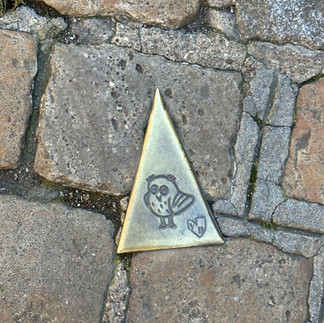One Day in Dijon, France
- ellen
- Oct 13, 2024
- 5 min read
Updated: Apr 9

Nestled among the rolling foothills in the Burgundy region of eastern France, Dijon is an easy day trip from Paris. You can reach Dijon in a mere hour and a half via the high-speed TGV from the Gare de Lyon. Even better, most of the central core of the city is pedestrian, making it easy to enjoy its many historical and picturesque landmarks.
Porte Guillaume

It's a quick walk from the train station to the historical center. If you arrive by train, you'll pass through Porte Guillaume (William Gate). This 18th century arch was actually built on the remains of the walls which surrounded Dijon centuries ago. Walk through the arch and you're on rue de la Liberté, one of the principal shopping streets in Dijon.
My first stop was the Office du Tourisme where for four euros I bought The Owl's Trail booklet. The Owl's Trail (or le Parcours de la Chouette) is a suggested walking route through Dijon which touches upon the 22 major tourist sights. They've even embedded bronze owls in the sidewalks to guide you. I roughly followed it, but veered off from time to time. The booklet was worth what I paid as it gives a short explanation of each of the sights.
No one knows exactly why the owl became the symbol of Dijon. Some say it represents the Eurasian "eagle-owl" recognizable by its feathered, pointy ears; some say it's a nod to the dukes of Burgundy and others say it represents the "Owl of Athena", the symbol of wisdom. In any case, it's now a symbol of good luck. As the legend goes, if you rub the owl with your left hand and make a wish, your wish will come true. The owl was added to the Church of Notre Dame around the 16th century and it's clear by its smooth appearance that many people have tested the legend.

Notre Dame

This 13th century church is situated right in the middle of the vielle ville, or old town.
Only a few gargoyles remain because as the legend goes, a moneylender who was being married at the church was killed by one which fell on him. The gargoyles were subsequently removed and it wasn't until the late 1800's that all of those we see now were added to the church.
The Jacquemart, or moving mechanical clock was manufactured in 1350 and sits atop the south tower of the church. It was given to the city of Dijon by one of the dukes of Burgundy in gratitude for supplying troops for a campaign in Flanders in 1382.

The original Jacquemart featured only a male figure. Eventually the citizens of Dijon wanted him to have a companion, so in 1651 a female, "Jacqueline", was added. Evidently that wasn't enough, because little "Jacquelinet" appeared in 1714 and "Jacquelinette" arrived in 1884. The structure weighs a whopping 7,400 pounds!

The inside of the church is 13th century Gothic architecture. A mass was taking place while I was there, so I didn't spend much time inside.

Maison Millière

This was one of my favorite stops in Dijon. The house was built in 1483 by Guillaume Millière, a medieval merchant. It housed a small shop on the ground floor while the family lived above it. Today it's a lovely café and gift shop.
Rue Verrerie and Half-Timbered Houses

Just around the corner from Notre Dame Church and Maison Millière is the rue Verrerie, one of the best examples of the half-timbered architecture that Dijon is famous for. Fortunately Dijon was spared the worst of the bombing of World War II, so much of the ancient architecture remained intact. Today rue Verrerie is home to antique shops.
The house in the photo below on rue de la Liberté is the oldest example of half-timbered architecture in Dijon. It's sometimes called "la maison des trois visages", or house of three faces. When I was there, only a part of it was visible due to restoration work being done on the rest of it.

Les Halles

Just at the edge of the Old Town sits the covered market which operates every Tuesday, Thursday, Friday and Saturday. I intentionally visited on a Friday so I could see the market. The metal structure was built in 1875. It was crowded with visitors and locals alike when I was there.
Place de la Libération

This lovely semi-circular square was designed in 1885 to receive the statue of Louis XIV and is considered one of the most beautiful royal squares in France. Unfortunately the statue was melted down like so many others were during the French Revolution.

The Palace of the Dukes and States of Burgundy dominate the square. Built in the 15th century, the buildings eventually became the residence of the king and governor of the province. The square had a number of names during the centuries. The current name was the result of the liberation of Dijon from the Nazis in 1944. It underwent a major renovation in the early part of the 21st century. You can make a reservation to climb the 316 steps of the tower, Tour Phlippe le Bon, from which I understand beautiful views of the surrounding countryside will reward you for your efforts.

Cathédrale Saint-Bénigne

This former abbey church was constructed in the Gothic style between 1280 and 1325 and is now listed as a national monument in France. The interior is beautiful.

Place François Rude

This iconic square is one of the first landmarks you'll come across walking into town. It was named after a famous Dijon sculptor who also sculpted a bas relief, "La Marseillaise" on the Arc de Triomphe in Paris. It's a great place to enjoy a glass of Burgundy wine as I did at the end of my day there.

Moutarde Maille and Moulot & Petitjean

In addition to its architecture, Dijon is known for mustard and gingerbread. You can't leave Dijon without either one! There are many shops selling mustard in town, but this is the most famous and they'll even mix it to your own specifications. You can also taste to your heart's content!
Pain d'épices, or "spice bread" is also a staple of Dijon. Don't leave without a couple of loaves of this delicious bread!
And Finally...
I had a wonderfully full day discovering Dijon. Here are a few final photos of this charming town.
➜ Top Tips
The train is an excellent way to get to Dijon. If you take the train, make sure you book a seat in advance because it's a popular destination, especially in the summer. If you drive you'll be able to explore the lovely surrounding countryside of the Bourgogne-Franche-Comté region.
I recommend stopping at the Office du Tourisme to purchase the Owl's Trail Guide. It will make your time there more enjoyable.
I saw a lot in one day, but staying overnight would let you explore even more.
Dijon's Museum of Fine Arts (Musée des Beaux Arts) was opened in 1787 and is one of the premier museums in France. I wasn't able to fit in a visit during my day, but try to get there if you can. It will be at the top of my list when I return.
Don't leave without some mustard and spice bread! (Note that mustard is considered a liquid by the airlines; I checked my suitcase on the return to accommodate the mustard I bought).



































































What a beautiful review, thank you, Ellen for such amazing photos that bring back fond memories of our last visit to Dijon!